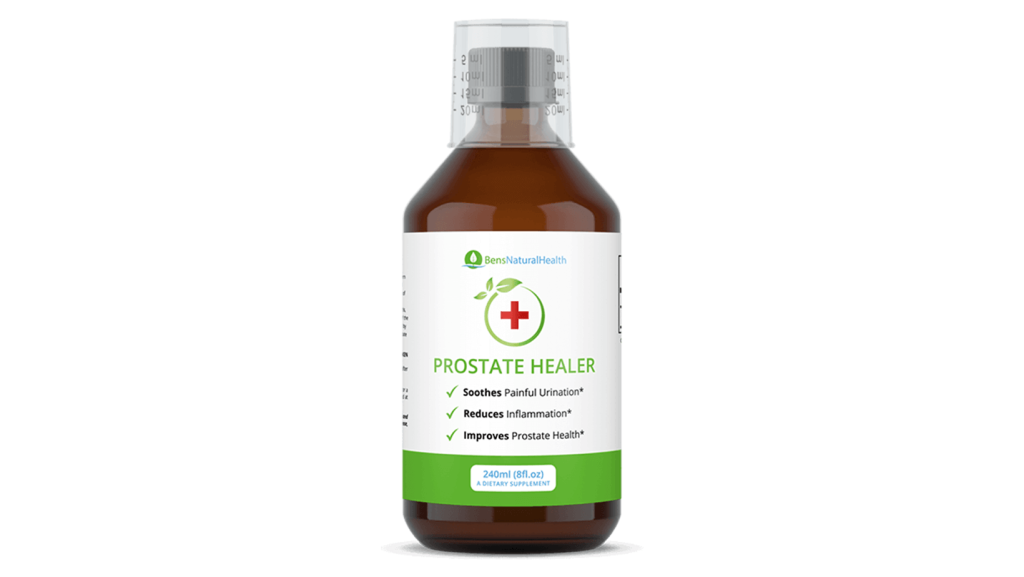- Q: What are the main similarities and differences between prostatitis and BPH?
- Q: What are the key differences of Prostatitis vs BPH that help distinguish these conditions?
- Q: Could you explain precisely what prostatitis is?
- Q: What exactly is BPH?
- Q: Are prostatitis and BPH the same prostate gland problem?
- Q: How can I tell the difference between prostatitis vs BPH
- Q: What about the symptoms specific to prostatitis?
- Q: How can people differentiate between these conditions?
- Q: What is the prognosis for BPH and prostatitis?
- Q: Are the treatments for prostatitis vs BPH different?
- Q: What medical treatments are available for BPH?
- Q: What is the medical treatment for chronic prostatitis?
- Q: Are there natural remedies that can help with prostatitis?
- Q: What about natural treatments for BPH?
- Key Patient Questions on BPH vs Prostatitis
- Conclusion
- Our Medical Review Process
- Our Editorial Guidelines
- Medical Disclaimer
- Source
If you want to know the difference between Prostatitis vs BPH, you’ve come to the right place. Both conditions affect the prostate gland and share similar symptoms, making them challenging to differentiate without understanding a few key points.
We spoke with Dr. Kelepurovski, a renowned urologist specializing in prostate health, to discuss the differences between prostatitis and benign prostatic hyperplasia (BPH). During the interview, Dr. Kelepurovski provided insightful perspectives on how inflammation differs from hyperplasia, how to identify each condition, and the various treatment options available. Dr. Kelepurovski has provided a comprehensive collection of resources, evidence, and research for this article. Throughout the content, you will find references to these materials, allowing you to explore the topics in greater depth. Additionally, all content has been thoroughly reviewed by a medical doctor to ensure accuracy and reliability.
In the following interview, Dr. Kelepurovski helps us understand the most important differences and similarities between these two common prostate conditions. We’ll explore how you can tell the difference, what treatments are available, and what prognosis to expect in each case.
Get Your FREE PSA Lowering Diet Plan!
- Naturally lower PSA levels
- Reduce nighttime trips to the bathroom
- Enjoy better bladder control and urine flow
Q: What are the main similarities and differences between prostatitis and BPH?
Dr. Kelepurovski answers: Let me first highlight the similarities between these two conditions. Both prostatitis and BPH share similar urinary symptoms, including increased urinary frequency and urgency. From a treatment perspective, we can manage chronic prostatitis and BPH with alpha-blockers. Additionally, natural treatments for both conditions may include saw palmetto extracts.
However, the differences are significant and important for diagnosis. Prostatitis features inflammation, while BPH is primarily a structural problem of the prostate. BPH typically presents with more urinary symptoms that you won’t see in a case of prostatitis. These symptoms typically develop as a result of blockage to the flow of urine due to the enlargement of the prostate. On the other hand, prostatitis often has symptoms of infectious diseases, such as fever and chills, which are absent in BPH. Perhaps most importantly from a treatment perspective, prostatitis is typically treated with antibiotics, which aren’t used for BPH.
Q: Could you elaborate on the similarities?
Dr. Kelepurovski answers: Certainly. Often presenting with overlapping urinary symptoms, prostatitis and benign prostatic hyperplasia (BPH) might first be confused by patients—and perhaps even by doctors.
The most often occurring shared symptoms consist of:
- more frequent urination—particularly at night, also referred to as nocturia
- urgency—an urgent desire for urination
- Hesitancy, or difficulty beginning urination
- weak urine stream
- unfinished bladder emptying
These symptoms arise since both disorders affect the urethral passage through the prostate by either compression or irritation. In BPH, this phenomenon results from the prostate physically enlarging. By aggravating the nerves and muscles surrounding the bladder and urethra, inflammation or chronic pelvic tension can produce comparable effects in chronic prostatitis.
From a treatment standpoint, alpha-blockers—such as tamsulosin or alfuzosin—may help both disorders. These drugs reduce symptoms by relaxing the smooth muscle in the bladder neck and prostate, therefore enhancing urine flow. In BPH, they are frequently used as first-line therapy; as research shows, they also form part of a multimodal treatment strategy in chronic prostatitis/chronic pelvic pain syndrome.
Furthermore, extensive research on BPH and prostatitis is a natural therapy, including saw palmetto (Serenoa repens) extracts. Studies have yielded varying findings, but saw palmetto is believed to reduce inflammation and potentially inhibit 5-alpha-reductase activity. Particularly in mild to moderate cases, some patients claim symptom relief.
Even though the main reasons differ, the similarities in symptoms and treatments make it essential to conduct a thorough diagnostic evaluation—typically including a medical history, physical exam, urine tests, and sometimes PSA (Prostatic Specific Antigen) testing or imaging—to tell the two apart.
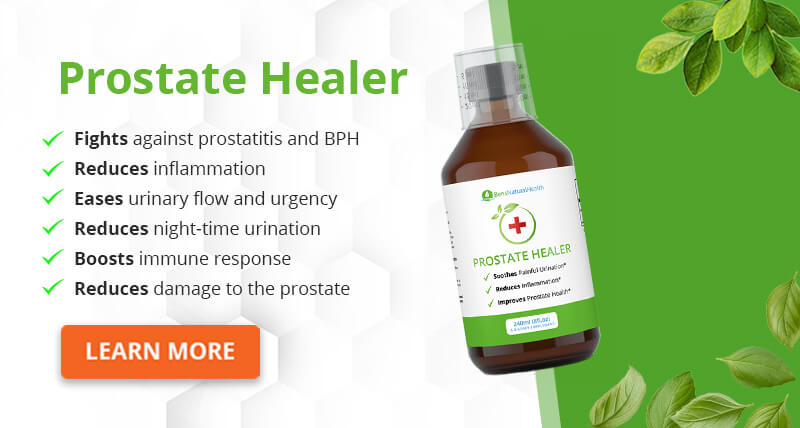
Q: What are the key differences of Prostatitis vs BPH that help distinguish these conditions?
Dr. Kelepurovski answers: The underlying causes of prostatitis and benign prostatic hyperplasia (BPH) set them apart fundamentally. Usually resulting from an infection, trauma, or autoimmune reactions, inflammation of the prostate gland defines prostatitis.
On the other hand, BPH is a non-cancerous enlargement of the prostate mostly caused by age-related hormonal changes, specifically the activity of dihydrotestosterone (DHT), which stimulates the growth of prostate tissue over time.
Their clinical presentation reflects these differences. Along with fever, chills, painful urination, and occasionally flu-like symptoms, prostatitis—especially in its acute bacterial form—can strike quickly with discomfort in the perineum, pelvis, or lower back. Though it may not show symptoms of infection, chronic prostatitis may also involve pelvic pain and discomfort during or following ejaculation.
Conversely, because of the physical compression of the urethra by the enlarged prostate, BPH usually produces a slow beginning of urine symptoms, including urinary hesitancy, weak stream, dribbling, incomplete emptying, and nocturia.
Diagnosis also varies. In prostatitis, urinalysis or culture often reveals infection in bacterial cases, and digital rectal examination (DRE) may reveal a tender prostate. BPH is usually detected through a combination of DRE, measurement of post-void residual volume, PSA testing, ultrasound, revealing an enlarged prostate and impaired urine flow measuring with uroflowmetry..
Treatment also differs quite a little. Antibiotics—such as fluoroquinolones or trimethoprim-sulfamethoxazole—are vital and typically given for several weeks in persistent cases of bacterial prostatitis. Antibiotics are useless for BPH, which is usually controlled with alpha-blockers (such as tamsulosin), 5-alpha-reductase inhibitors (such as finasteride,dutasteride), or surgical procedures including TURP (transurethral resection of the prostate) for more severe obstruction.
Recognizing these differences is essential for accurate diagnosis and effective treatment of both conditions.
Q: Could you explain precisely what prostatitis is?
Dr.Kelepurovski answers: Prostatitis is an inflammation or swelling of the prostate gland. In these cases, inflammatory substances invade the prostate tissue and modulate the permeability of blood vessels. As a result, more liquid is retained in the prostate, and more white blood cells accumulate in the gland. These white blood cells continue releasing more inflammatory substances, perpetuating the inflammatory process.
There are two main types of prostatitis. Acute bacterial prostatitis has a sudden onset, and the symptoms are often more severe. Chronic prostatitis has an insidious onset, and the symptoms are generally not as severe.
Among the most frequent causes, we have urinary infections and sexually transmitted diseases. However, it’s worth noting that in many cases, the cause of prostatitis remains unknown.
Q: What exactly is BPH?
Dr. Kelepurovski answers: BPH stands for Benign Prostatic Hyperplasia. It’s an alteration of the prostate tissue itself. To understand BPH better, we need to recognize that there are two types of growth in human tissues: hypertrophy and hyperplasia.
Hypertrophy is an increase in the size of cells, where the affected cells grow without dividing. A characteristic example would be muscle hypertrophy, common in bodybuilders. On the other hand, hyperplasia is a type of growth that features an increase in the number of cells. Each cell remains the same size as in healthy tissue, but there are more cells than usual.
Both hypertrophy and hyperplasia can occur in the body under normal circumstances. However, in the case of BPH, hyperplasia is not considered normal, and it affects the normal function of the urinary tract.
Current research is still trying to fully understand the reasons behind prostatic hyperplasia. What we do know is that there are risk factors. One of the most important is age, as BPH becomes more common as men grow older. Genetics also play a role, especially if a first-degree relative, such as a father or brother, has the condition.
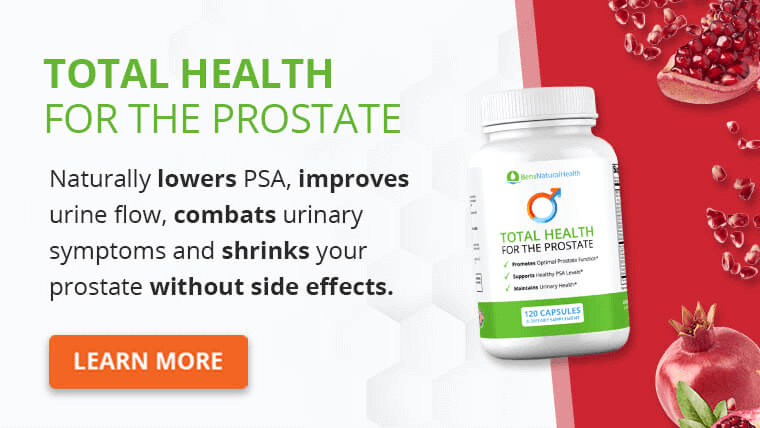
Q: Are prostatitis and BPH the same prostate gland problem?
Dr. Kelepurovski answers: Especially in older men who have overlapping urinary symptoms including increased frequency, urgency, or difficulty urinating, prostatitis and benign prostatic hyperplasia (BPH) are sometimes confused for one another. Notwithstanding these parallels, the fundamental processes are quite different and call for different diagnosis and treatment approaches.
Prostatitis is essentially an inflammatory condition of the prostate gland. It can be acute or chronic, and it can involve or not a bacterial infection. A urinary tract infection, which can come from common bacteria like Escherichia coli or sexually transmitted infections like Chlamydia trachomatis or Neisseria gonorrhoeae, leads to the swelling and irritation seen in bacterial prostatitis. These infections cause edema, inflammation, and prostate and surrounding tissue pain as well as the release of inflammatory cytokines.
Significantly, prostatitis does not include hyperplasia—that is, no aberrant expansion of prostate cells. The prostate swells instead as a result of tissue edema and fluid accumulation brought on by the inflammation. Although the process is entirely different, this transient swelling may constrict the urethra and resemble obstructive symptoms observed in BPH.
Though most commonly occurring in chronic pelvic pain syndrome (CPPS), prostatitis can also arise without an infection. With no clear culprit, this disorder is believed to comprise neuromuscular dysfunction, pelvic floor strain, immunological dysregulation, and psychological stress.
By contrast, benign prostatic hyperplasia (BPH) is a chronic, non-inflammatory enlargement of the prostate gland. It results from hyperplasia, the proliferation of stromal and epithelial cells inside the prostate, especially in the transition zone around the urethral opening. Age-related hormonal changes, notably the activity of dihydrotestosterone (DHT), a strong derivative of testosterone, cause this increase.
BPH, unlike prostatitis, is not linked to pain, infection, or systemic symptoms like fever or chills. It causes problems with urination, such as difficulty starting, a weak flow, needing to go at night, not being able to fully empty the bladder, and needing to urinate often, and it gets worse over time. Over time, this chronic blockage might cause problems, including renal malfunction, bladder hypertrophy, or urine retention.
Q: How can I tell the difference between prostatitis vs BPH
Dr. Kelepurovski answers: The symptoms of prostatitis and BPH are indeed similar, which explains why they’re often confused. Let me walk you through the distinct symptoms of each condition.
BPH has several characteristic symptoms that develop gradually as the prostate enlarges. These include:
BPH is sometimes asymptomatic
Not every patient with prostate enlargement experiences symptoms immediately. In many cases, BPH symptoms only become noticeable when the prostate has grown very large. Other patients experience a gradual increase in the incidence and severity of symptoms. Because of this insidious progression over many years, some patients may not even realize they have symptoms until they become more pronounced.
Frequent urination
This is one of the most common initial symptoms of BPH. Patients report a frequent need to urinate. This occurs because the enlarged prostate impairs the capacity of the urinary bladder. As the prostate grows larger, it affects the normal storage function of the bladder.
Nocturia
Nocturia refers to waking up multiple times during the night to urinate. These patients often experience sleep problems and may even wet their sheets in severe cases. Nocturia is a common problem, and in severe cases, it doesn’t improve even after reducing water intake at night.
Urgency to urinate
Patients with BPH often experience a sudden and very urgent need to urinate. This may even lead to urinary incontinence, where the patient loses control of their bladder due to the overwhelming urge to urinate.
Reduced flow of urine
It’s important to evaluate the caliber of the urine flow. Most patients with BPH notice their urine flow is reduced and slower than usual. Sometimes, they feel they haven’t emptied their bladder completely even after they’ve finished urinating.
Hesitancy and intermittency
BPH patients may need to push harder to start urinating, a condition known as urinary hesitancy. This sometimes causes urinary retention. Another symptom is intermittent or interrupted urinary flow. Instead of a continuous stream, patients need to stop and push again to continue urinating.
Terminal and post-micturition dribble
Patients with BPH often experience terminal dribble, which means they start dribbling urine after the main flow has ended. Moreover, after the patient has finished urinating, they may experience post-micturition dribble. This can sometimes be mistaken for incontinence.
Q: What about the symptoms specific to prostatitis?
Dr. Kelepurovski answers: Prostatitis presents with its own set of symptoms, some of which overlap with BPH, but others that are distinct:
Prostatitis is sometimes asymptomatic
Some cases, especially asymptomatic inflammatory prostatitis, may not present any noticeable symptoms despite inflammation being present.
Weak urinary stream
Similar to BPH, patients with prostatitis may sometimes experience a weak urinary flow. They may need to push to continue urinating, and the symptoms can be acute or chronic. In chronic cases, weak urinary stream symptoms are intermittent.
Increased urinary frequency and urgency
Another similarity with BPH is that patients experience urgency to urinate and increased frequency. These symptoms are due to inflammation of the prostate gland. Since the gland is continuous with the bladder, the inflammation irritates this organ.
Fever and chills
This is where prostatitis begins to differ significantly from BPH. Instead of solely having urinary symptoms, patients may also experience fever. High temperature levels are indicative of infection and common in acute bacterial prostatitis.
Muscle and joint pain
As part of the inflammatory process, patients with prostatitis may experience joint pain and muscle pain, which aren’t typically seen with BPH.
Prostatic pain, pelvis, or low back pain
In prostatitis, patients will have swelling and tenderness of the prostate gland. Doctors need to evaluate how a digital examination triggers pain. In some cases, patients complain of dull pain in the pelvic area. In others, it’s moderate back pain associated with prostatitis.
Urethral discharge
Some patients with prostatitis will also have a urethral discharge. These cases are associated with sexually transmitted diseases of the urinary tract, causing urethritis.
Painful urination
In other cases, patients with prostatitis experience painful urination, primarily when associated with cystitis or lower urinary tract infections.
Recurrent urinary infections
Men do not have urinary infections as commonly as women. Urinary infections in men are often a complication of another process. They can also cause potential complications such as prostatitis. Therefore, recurrent urinary infections should be investigated, especially in male patients.
Q: How can people differentiate between these conditions?
Dr. Kelepurovski answers: You’ve probably noticed that both prostatitis and BPH share lower urinary symptoms. These include voiding symptoms, storage symptoms, and post-micturition symptoms. In prostatitis, the most predominant are storage symptoms.
For example, having urinary urgency, incontinence, waking up several times at night to urinate, and having increased volume and frequency of urination.
Voiding symptoms such as weak urinary flow may appear in patients with prostatitis. However, they are much more common and gradually progressing in BPH. Post-micturition symptoms are almost solely found in BPH patients.
The key differentiators are that chronic inflammation and bacterial infection only occur in prostatitis, not in BPH. If you have symptoms such as fever, chills, urethral discharge, joint, and muscle pain, it is most likely prostatitis instead of BPH. It is prostatitis that causes prostate pain triggered by digital examination.
Q: What is the prognosis for BPH and prostatitis?
Dr. Kelepurovski answers: Unlike prostate cancer, prostate BPH is a benign disease. Prostatitis is also benign and even more manageable than BPH. Thus, both disorders have a very favorable prognosis.
However, patients with prostatitis and BPH should undergo careful follow-up. This is a useful way to make sure their condition is being controlled appropriately. Otherwise, they could be affected by complications that will impact their quality of life.
Among the most important methods to evaluate the prognosis, we have PSA levels. With PSA testing, it is possible to determine when prostate cancer might be the cause of an increase in the size of the prostate.
In the majority of cases, a prostate biopsy won’t be required. On the other hand, prostatic abscess formation is a potential complication of prostatitis. It is very rare and often appears in immunocompromised patients.
In chronic prostatitis, it’s a more insidious process, but with more consequences. Prostatitis does not cause mortality but can impair the patient’s quality of life. Chronic cases are linked with erectile dysfunction when they feature severe symptoms.
Q: Are the treatments for prostatitis vs BPH different?
Dr. Kelepurovski answers: It is fundamental to make a clear distinction between prostatitis and BPH. Understanding what is really happening allows us to create an appropriate treatment plan.
Both conditions are treated differently. Moreover, various types of prostatitis will have different treatment options. Let me review the medical treatment of BPH and compare it with the most common types of prostatitis (acute and chronic prostatitis).
Q: What medical treatments are available for BPH?
Dr. Kelepurovski answers: The drugs used to treat BPH depend on the patient, their symptoms, and the extent of the disease. The main options include:
Alpha receptor blockers
This medication is designed to relax the smooth muscle. It works in the muscle of the urinary tract, the bladder, and the prostate. Thus, the urinary tract won’t be constricted, and the urine will have a better flow. One of the most common is tamsulosin or Flomax. Other alternatives include terazosin, doxazosin, and alfuzosin.
Anticholinergic agents
These are useful for patients with overactive bladder symptoms. But they should be used only when there is no bladder outlet obstruction to avoid the risk of urinary infections. They can be combined with alpha-receptor blockers, but this should be done with care.
Phosphodiesterase inhibitors
These are a useful alternative to alpha-receptor blockers. One of the possible mechanisms of action includes the relaxation of the smooth muscle. However, phosphodiesterase inhibitors reduce hyperactivity in the autonomic nervous system that causes increased frequency of urination, urgency, and other symptoms.
Surgical removal of the prostate
In selected cases, it may be an option to remove the prostate. This is usually done through transurethral resection of the prostate, a procedure also known as TURP.
Q: How is acute prostatitis treated?
Dr. Kelepurovski answers: Acute prostatitis is often a medical emergency. The symptoms are more severe and have a sudden onset. The most common medical treatments for acute prostatitis are:
- Antibiotic therapy: Acute prostatitis is often due to a bacterial infection of the prostate. Thus, the most appropriate treatment is antibiotics. With trimethoprim or fluoroquinolones, prostatitis usually resolves in a few days. However, you should maintain treatment for as long as your doctor instructs.
- Nonsteroidal anti-inflammatory drugs: Your doctor may also recommend NSAIDs. As research shows, these anti-inflammatory medications are useful to control pain symptoms associated with prostatitis.
Q: What is the medical treatment for chronic prostatitis?
Dr. Kelepurovski answers: The treatment of chronic prostatitis is similar to what we have described for acute prostatitis. However, recovery often takes longer. It is also more common to use multiple medications in the same patient to control the symptoms. The most important drugs are:
Antibiotics: Once again, infection is often the cause of chronic bacterial prostatitis. However, in this case, the infection may take a very long time to cure, and therapy may extend for more than two months.
Alpha-blockers: Patients with urinary tract symptoms and prostate pain usually need alpha-blockers. They are often diagnosed with chronic pelvic pain syndrome and need these drugs to relieve their urinary tract symptoms.
Nonsteroidal anti-inflammatory drugs: They are required in most cases of chronic prostatitis, especially in chronic pelvic pain syndrome.
Q: Are there natural remedies that can help with prostatitis?
Dr. Kelepurovski answers: Yes, several natural treatments have shown promise for prostatitis:
Quercetin
Quercetin is a potent anti-inflammatory substance. It relieves the symptoms of prostatitis by countering the prostate inflammation.
Turmeric
This is a widely used spice in India and many other parts of Asia. Most of the medicinal properties of Turmeric are attributed to the presence of a compound called curcumin in it. Turmeric has powerful anti-inflammatory potential. It also displays antibacterial properties. Thus, it reduces inflammation and helps the organism fight pathogenic microbes.
Saw Palmetto
This herb is very abundant and widely used in North America. Saw palmetto helps patients improve their hormonal balance and contains a very potent group of antioxidants called flavonoids. These flavonoids are powerful anti-inflammatory substances. They reduce inflammation and improve urinary symptoms.
Prostate Healer
We formulated Ben’s Prostate Healer to re-establish a healthy estrogen-testosterone balance by supplying phytoestrogen compounds. Phytoestrogen compounds mimic the action of estrogen and, as a result, discourage excessive estrogen production.
The tincture also purges the urinary tract, effectively boosting kidney efficiency, toning bladder tissue, and reducing residual volume. As such, it may also improve urinary symptoms associated with prostatitis.
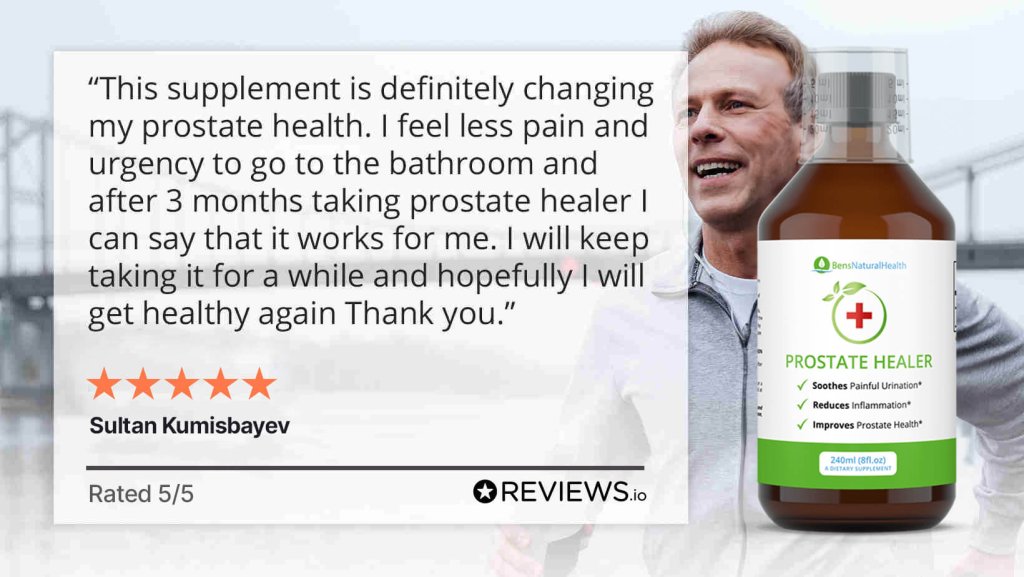
Prostatitis (inflammation of the prostate) is one of the most common prostate health problems experienced by men.
In fact, approximately 50% of men experience symptoms of prostatitis at some point during their lifetime.
Although not a life-threatening condition, painful urinary symptoms, and relentless urinary tract infections have a debilitating effect on your quality of life.
Prostate Healers antiviral ingredients help to prevent and fight off urinary tract infections effectively.
Q: What about natural treatments for BPH?
Dr. Kelepurovski answers: For BPH, there are also several natural options that have shown benefits:
Ellagic Acid
This is an antioxidant we can find in various foods, especially in many types of berries and pomegranates. It slows down the progression of benign prostatic hyperplasia and may help prevent the onset of prostate cancer.
Stinging Nettle
This is a traditional herb used against back pain, joint pain, and BPH. Stinging nettle can reduce the post-void residual urine in patients with BPH. In other words, it allows for more complete emptying of the urinary bladder.
Saw Palmetto
Similar to prostatitis, saw palmetto is beneficial in BPH. In these patients, it reduces the incidence and severity of urinary symptoms.
Total Health

Total Health for the Prostate is a blend of essential vitamins, minerals, and nutrients, backed up by a wealth of clinical studies.
Further, each individual ingredient is thoroughly researched and scientifically proven to improve and maintain prostate health.
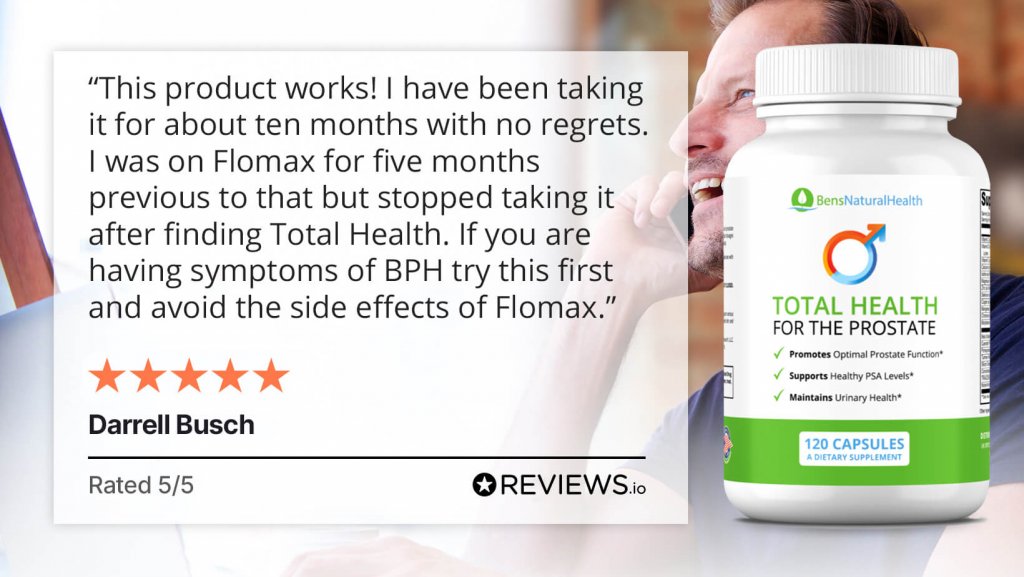
Containing clinically significant dosages of beta-sitosterol, quercetin, pomegranate extract, boron, and turmeric, many of the nutrients included in Total Health have been shown to improve urine flow, reduce frequent urination, and lower your PSA score.
Prostate Power
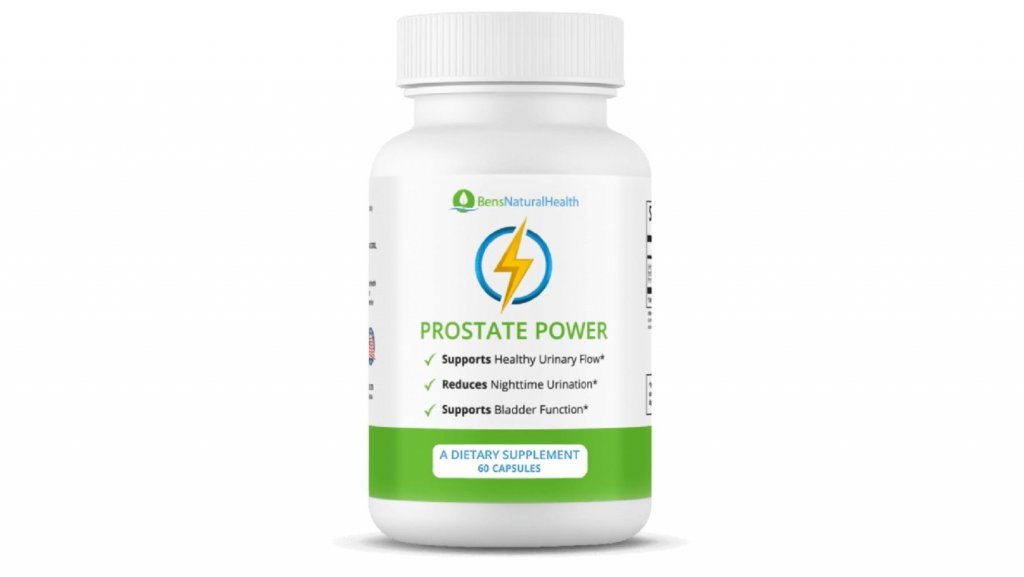
Our dietary supplement, Prostate Power, contains ingredients clinically proven to shrink an enlarged prostate and slow the progress of BPH and prostate disease.
Numerous clinical trials and meta-studies show the key active ingredients in Prostate Power can shrink prostate volume, improve urine flow and decrease the risk of acute urinary retention.
Why Choose Ben’s Natural Health Supplements?
At Ben’s Natural Health, our motto is to combine holistic healing with modern science.
Ben’s Natural Health is the world’s first high-quality, all-natural, scientifically proven clinical supplement company.
Our supplements are effective, natural and 100% side effect free.
Moreover, at Ben’s Natural Health, we have four rules for all our supplements:
- We only use the highest quality ingredients
- We only use them if independent, peer-reviewed double-blind studies prove they work
- With all our supplements, we find a way to get every ingredient into a single bottle
- We always formulate them in clinically significant doses of the most bioavailable form
We pride ourselves on offering excellent customer service. We offer a free health consultation where you can ask questions and receive tailored advice from our expert health consultants.
Key Patient Questions on BPH vs Prostatitis
Q: How do lifestyle factors and dietary habits influence the progression of prostatitis and BPH?
Dr. Kelepurovski answers: Not only can lifestyle choices and eating habits affect how prostatitis and benign prostatic hyperplasia (BPH) develop, but also the degree of symptoms and general quality of life.
In the case of prostatitis—especially chronic pelvic pain syndrome (CP/CPPS)—some foods and behaviors might set off symptom flare-ups. Many patients say that foods high in spices, caffeine, alcohol, and acids—such as citrus or tomatoes—tend to aggravate pelvic pain or urine urgency.
On the other hand, following an anti-inflammatory diet high in fruits, vegetables, whole grains, probiotics, and omega-3 fatty acids can help control chronic inflammation and lower symptoms. Research indicates that CP/CPPS is mostly caused by inflammation; hence, controlling symptoms might benefit much from food triggers being avoided.
Conversely, BPH is a slow-progressing disorder that typically gets more troublesome as one ages. Moreover, diet affects its development. Studies have indicated that a diet heavy in dairy products, red meat, and saturated fats can aggravate urinary problems and raise prostate enlargement risk. Conversely, a diet high in vegetables, fiber, lycopene-containing foods including tomatoes, soy products, and antioxidants could be protective. Green tea and meals high in zinc are also showing possible advantages in maintaining general prostate health.
Another important element helping both disorders is physical exercise. Regular exercise helps improve circulation, lower pelvic floor strain, and control stress in prostatitis—all of which can help to lower the frequency and intensity of symptom flares. Men with BPH seem to slow down the rate of prostate progression and lessen the intensity of their urinary symptoms through physical activity. While males who engage in moderate-to-vigorous exercise tend to report greater urine flow and less discomfort, sedentary activity is linked with worse outcomes. Kegel exercise is particularly recommended for improving urine flow and reducing urinary incontinence associated with BPH.
Maintaining a healthy weight is absolutely vital for both prostatitis and BPH since obesity is linked to a higher risk of urinary tract dysfunction, hormonal imbalance, and systemic inflammation. Despite not being curative, dietary and lifestyle changes significantly aid in the management of both prostatitis and BPH.
Q: Can stress and mental health impact the symptoms of prostatitis or BPH?
Dr. Kelepurovski answers: Stress and mental health can have a major influence on the symptoms of both benign prostatic hyperplasia (BPH) and prostatitis, but the effect is more noticeable in prostatitis, especially in cases of chronic pelvic pain syndrome (CPPS).
Psychological stress is seen in chronic prostatitis/CPPS as both a trigger and an amplifier of symptoms. Though it is not brought on by an infection, this type of prostatitis is frequently associated with pelvic floor muscle dysfunction, neuropathic pain, and a higher pain response—all of which can be impacted by emotional and psychological conditions. Men with chronic prostatitis have demonstrated in studies more anxiety, sadness, and stress, which can aggravate pelvic discomfort, urine urgency, and sexual dysfunction. All of which aggravate symptoms are the tense pelvic muscles brought on by stress, decreased blood flow, and changed nerve sensitivity in the area. This cycle may turn self-perpetuating since tension results from pain and vice versa.
Treating chronic prostatitis now depends much on mental health management. Often advised in tandem with medical treatment are cognitive-behavioral therapy (CBT), mindfulness, relaxation techniques, and pelvic floor physical therapy aiming at lowering muscle tension. Long-term symptom alleviation and quality of life in these individuals depend on psychological well-being being addressed.
By contrast, BPH is a structural, hormonal disorder in which stress neither causes nor aggravates the underlying enlargement of the prostate. Still, stress can affect how patients see and manage mild lower urinary tract problems. Anxiety, for example, can aggravate sleep quality and raise awareness of urine urgency or frequency—especially in people who already suffer from nocturia, or overnight urination. Furthermore, indirectly aggravating urinary symptoms related to BPH are stress-related lifestyle choices, including poor sleep, less physical activity, or too much coffee intake.
Under both circumstances, controlling stress and supporting mental health can help to lower flare-ups, enhance the efficacy of medical treatment, and change the way symptoms are experienced. Especially in chronic prostatitis, a complete approach including lifestyle change, mental health assistance, and regular urological treatment is usually the most successful one.
Q: What role do regular check-ups and monitoring play in managing these prostate conditions over time?
Dr. Kelepurovski answers: Early detection, correct diagnosis, and efficient treatment of both prostatitis and benign prostatic hyperplasia (BPH) depend critically on regular check-ups and continuous monitoring. While their etiology and course are different, both of these disorders might profit much from regular medical examination.
Regular visits assist in monitoring the course of symptoms and directing therapy changes for prostatitis, especially in chronic or recurrent forms. Ongoing monitoring lets doctors evaluate response to drugs, physical therapy, or lifestyle modifications, as chronic prostatitis—including chronic pelvic pain syndrome (CPPS)—can be erratic and complex in character.
It also helps determine whether more research is required—for example, whether symptoms get worse or if there is worry about overlapping diseases like urinary tract infections or even early stages of prostate cancer. Regular occurrences of acute bacterial prostatitis could also call for additional urological investigation to search for structural defects likely to cause infection.
Regular monitoring is also vital in the case of BPH, particularly because the condition usually advances slowly over time. Routine tests can determine whether bladder function is being compromised, whether urinary symptoms are getting worse, and whether the prostate is still getting enlarged.
Disease development can be tracked, and treatment decisions can be made using instruments such as the International Prostate Symptom Score (IPSS), post-void residual measures, uroflowmetry, and PSA testing. Early treatment or, in certain circumstances, minimally invasive surgery can help to avoid consequences including kidney damage, bladder stones, or urine retention.
Especially in males over the age of 50 or those with a family history of prostate cancer, frequent visits also offer a chance for screening or the disease. High PSA levels or abnormal results from a digital rectal exam could call for additional testing.
All things considered, regular follow-ups help guarantee that both prostatitis and BPH are suitably controlled over time. If more extensive therapy is required, they enable early identification of problems, assist in customizing treatments to address changing symptoms, and enable quick referral. Maintaining both prostate health and general quality of life depends on keeping involved with a healthcare practitioner.
Q: Is it possible to have both BPH and prostatitis simultaneously?
Dr. Kelepurovski answers: In clinical practice—especially in older men—this is not unusual; it is quite likely for a patient to have both benign prostatic hyperplasia (BPH) and prostatitis concurrently.
Though in distinct ways, these two diseases impact the same organ—the prostate. BPH, which usually develops as men get older, is a non-cancerous swelling of the prostate gland. Particularly at night, it causes slow urinary blockage that results in symptoms like weak urine stream, hesitation, incomplete emptying, and higher frequency.
Conversely, an inflammatory disorder with either a bacterial or non-bacterial cause is prostatitis. If it’s an acute infection, it could produce symptoms including pelvic pain, burning during urination, pain after ejaculation, and occasionally fever and chills.
When both illnesses are present, the urine symptoms may coincide and get more severe, which complicates diagnosis. For instance, BPH can explain urgency and frequency; yet, the existence of pelvic discomfort or systemic symptoms would suggest prostatitis. Actually, by inducing urine retention, which can aggravate an infection, BPH can occasionally cause a man to become prone to acquiring prostatitis—especially the bacterial form.
Having two problems calls for a thorough approach to therapy. While bacterial prostatitis calls for antibiotics, BPH is usually controlled with drugs such as alpha-blockers or 5-alpha-reductase inhibitors.
Treatment for nonbacterial prostatitis or chronic pelvic pain syndrome could also include pelvic floor therapy, anti-inflammatories, or neuromodulation devices.
Effective symptom relief and long-term prostate health depend on differentiating and treating both illnesses suitably.
Q: Are there any emerging therapies or research developments that might change the management of prostatitis or BPH in the near future?
Dr.Kelepurovski answers: Indeed, various new treatments and continuous research projects show promise for near-future diagnosis and treatment of benign prostatic hyperplasia (BPH) as well as prostatitis.
Particularly chronic prostatitis/chronic pelvic pain syndrome (CP/CPPS), which remains one of the most difficult urological disorders to treat, researchers are investigating new anti-inflammatory agents, neuromodulators, and immunotherapies that target the underlying mechanisms more precisely.
To lower chronic pelvic inflammation, for instance, researchers are looking at treatments emphasizing immunological regulation and mast cell stabilization. Researchers are also paying more attention to the microbiome because early studies suggest that changes in the bacteria in the gut and urogenital areas might influence inflammation and pain sensitivity in CP/CPPS. Eventually, personalized probiotic therapies could be part of therapy.
Furthermore, low-intensity shockwave therapy (Li-ESWT) and transcutaneous electrical nerve stimulation (TENS) are increasingly becoming popular non-invasive treatment options for men with chronic pelvic pain who do not respond to drugs. These techniques seek to increase pelvic blood flow, lower nerve sensitivity, and release muscular tension. Already in use, pelvic floor physical therapy is developing with more focused techniques and integration into multidisciplinary treatment models.
For BPH several emerging therapies are set to change how we manage benign prostatic hyperplasia (BPH).
Originally used for an overactive bladder, vibegron —a beta-3 adrenergic receptor agonist—is an exciting new medication being tested for men with BPH-related urgent and frequent urination. Combining treatments for urinary problems and erectile dysfunction concurrently is also attracting interest for finasteride with tadalafil.
The function of chronic inflammation in BPH progression is under investigation by researchers, which might result in fresh anti-inflammatory medicines slowing down disease growth.
Faster recovery periods and improved preservation of sexual function are driving popularity of minimally invasive treatments such as Rezūm, UroLift, and Aquablation. Particularly for males looking for less involved solutions, these outpatient procedures provide alternatives to conventional surgery.
Advances in MRI and AI-assisted imaging are changing our diagnosis and therapy planning for prostate enlargement. These technologies enable individualized therapy depending on prostate anatomy and inflammation degree.
These advances taken together suggest a future for BPH in more focused, efficient, patient-friendly techniques. Research will help management to become more customized with greater results and fewer adverse effects.
Conclusion
In summary, both prostatitis and BPH are non-mortal conditions but can significantly impact quality of life through various urinary symptoms and discomfort. While prostatitis is associated with inflammation and may present with additional systemic signs such as fever and pain, BPH is a result of prostate enlargement leading predominantly to obstructive urinary symptoms. Regular monitoring and tailored treatment plans are essential to managing both conditions and preventing complications.
Please consult with your healthcare provider before initiating any antibiotic treatment to ensure it is appropriate for your specific health needs.
Our Medical Review Process
At Ben’s Natural Health, we are committed to maintaining the highest standards of accuracy, transparency, and scientific rigor. Our content is carefully developed by medical professionals and undergoes a thorough review process every 12 to 24 months. This ensures that our information stays current, precise, and based on reliable, evidence-backed research. We exclusively reference peer-reviewed studies from trusted medical journals and provide full citations and direct links to enhance transparency and build trust. For more information about our medical review process and research standards, click here.
Our Editorial Guidelines
For over 25 years, Ben’s Natural Health has been a trusted authority on natural health, offering scientifically accurate and reliable information. Our editorial guidelines ensure the quality and integrity of each article we publish. Every piece is authored by qualified professionals, including doctors, dietitians, nutritionists, fitness experts, and surgeons, and undergoes independent quality checks. We prioritize transparency by displaying the credentials and biographies of our contributors at the start of each article. To learn more about how we create and fact-check our content, read our editorial guidelines.
Medical Disclaimer
The content on this blog is intended for informational purposes only and should not be used as a substitute for professional medical advice, diagnosis, or treatment. While our articles are written and reviewed by licensed medical professionals, they may not address your unique health needs. Always consult your primary care physician or a qualified healthcare provider before making any decisions regarding your health. Do not disregard or delay seeking professional medical advice based on information from this blog. Your use of this content is at your own risk.





